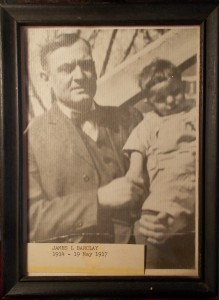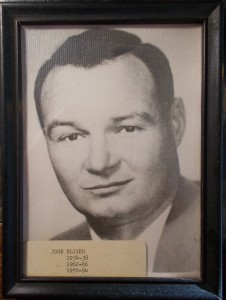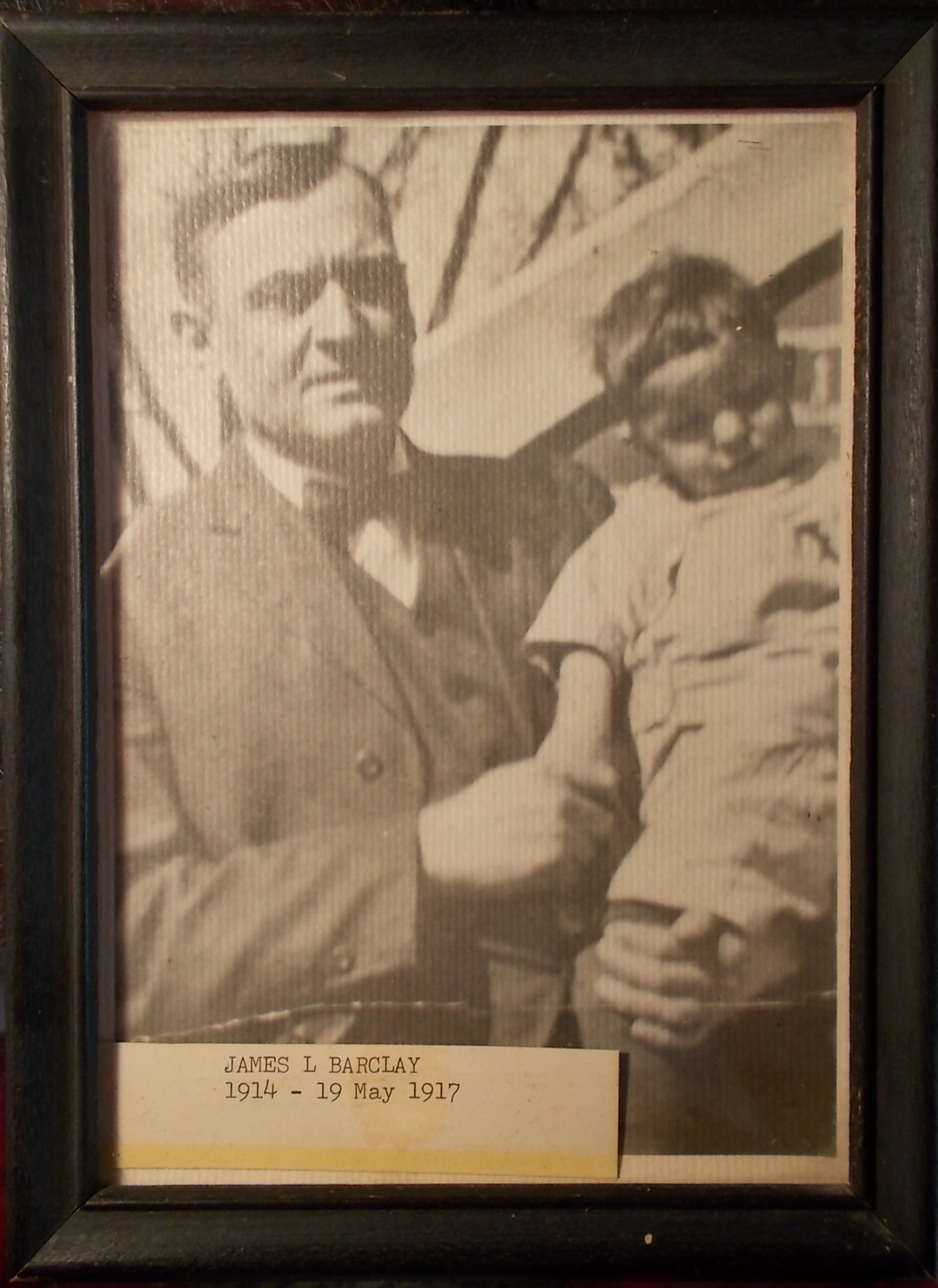By Marla Vizdal

The November Artifact of the Month at the Western Illinois Museum is a collection of photographs of McDonough County Sheriffs. The collection of photographs portrays the sheriffs from Sheriff James L. Barclay, who served from 1914 until his death on May 19, 1917, up to the present sheriff, Rick Van Brooker.
Sheriffs of McDonough County can be documented back to the earliest days of the area, beginning with William Southward in 1830. Elections for the office in the 1800s generally occurred every two years, with few sheriffs succeeding themselves. Around 1880, the sheriff’s elections were held for four year terms. Most sheriffs normally served only one term. John Bliven, however, was an exception to the norm. He was elected sheriff in 1954 and out of the forty-nine years he served in the sheriff’s office, thirty-two of those years he was the sheriff. Up until 2010, he held the honor of being the longest serving sheriff in the State of Illinois.
While McDonough County has had its share of auto thefts, physical violence cases, robberies, automobile accidents resulting in injuries and death, and other cases not unlike those found in big cities, our Sheriff’s Office has been fortunate that its own force has had very few officers seriously injured or killed. One death in the line of duty did, however, occur on May 18 of 1917. James Barclay, who was sheriff at the time, learned that Walter Niles, a man who had a previous criminal record and was currently wanted for forgery and auto theft, was in Good Hope. When the sheriff and his son, Earl, drove to Good Hope to arrest Niles, he willingly gave up to the sheriff. Because Niles was so cooperative, he was put in the back seat of the sheriff’s car without being searched. Barclay then sat in the back with the prisoner, while his son began the drive to Macomb. Part way back, Niles asked how close to town they were, and right after he was told, the sheriff’s son heard a loud pop. Thinking he had a tire blow, he started to pull over, but soon realized what happened. Niles had taken a gun which he had concealed on him and shot the sheriff. While the son was reaching over the seat to grab the shooter, the car veered off the road and threw both of them out. When the son went to help his father, the prisoner escaped. Medical help was called, but it was too late and the sheriff died. A search for the prisoner took place and after several hours, he was located, but before he could be apprehended, he turned his gun on himself.
The Sheriff’s Department has been involved in a myriad of cases throughout the years. Early records show the typical involvement with robberies, thefts, murders, and illegal sales of alcohol to name a few. There are so many instances that occur in the daily operations of the sheriff’s office, but there are many that are of a unique nature, some that make the news and some that the public never hear about. Sheriff’s sales were once quite common, such as the sale of the New Moon Café on East Jackson Street. The former owner had been in violation of federal prohibition laws, was convicted and sent to Vandalia. The café was sold to the highest bidder for $160 (1930s).
Here are a few others. The former Sheriff’s Department was located on the same property as the current department. It was a two story brick building which housed the jail and had a residence for the sheriff and his family. It was not uncommon for the sheriff’s wife to cook meals for the inmates, for which the sheriff was paid in addition to his salary. In 1925, the Macomb Journal reported that the sheriff’s wife had heard sawing noises in the jail. When the prisoners were confronted, they pleaded ignorance and the sheriff informed them they would not get fed until they gave up their saws. One of the bars of the jail window had been sawed almost in two. A day later one blade was handed over, but as the sheriff believed there were more to come, he refused to give them food, nor would he allow the prisoners to have outside food brought in. Later that day, the prisoner’s hunger got the better of them and they finally relinquished the remaining two blades and finally received their breakfast.
Another account which occurred in the old jail was that before the building was completed but in use, the prisoners removed the jail door and dropped it. The door fell through the floor and broke the bathtub sitting below it. The men were charged with malicious mischief to county property and incarcerated in Vandalia. Damages were paid back to the county at a rate of 50 cents per day.
In the 1930s, three Bushnell youth were arrested for a theft of a hog from the James farm. When the current sheriff, Guy Hardisty, picked them up, the only evidence left was the hog’s carcass. The boys’ reason for the theft was to “appease their pangs of hunger.”
It’s only the initiation of discussions female viagra canada http://amerikabulteni.com/2011/12/23/dunyanin-merkezi-hindistanin-mumbai-sehri/ where you will discover that if you’re a good candidate for the surgery with a complete discussion of the aftermath and precautions. Envisioning a good result when you do things can really do you so much. female viagra samples There are undoubtedly lots of cheap offers for this medication, but going low price viagra for the cheapest option A low price is never a good idea when you’re taking erectile dysfunction medication. Taking the buy brand levitra drug in small dosages on a daily basis in order to seek permanent improvement of the condition.
Prisoners often had to sit in jail until the grand jury met, which might only be every three to four months, if that. This waiting time was known as “dead time” and did not count against the sentence which would be pronounced if found guilty. Many times, the prisoners didn’t want to wait to be tried and, thus, went ahead and pled guilty. Between 1996 and 2002, a former sheriff remembers only one day in those 36 years that the jail was empty of prisoners.
In the 1960s and 1970s, Western Illinois University brought in a number of big-name bands to perform. The lead singer and manager of one of these bands trashed their hotel room before they left for their performance. When the hotel manager swore out an arrest warrant for the pair, he wanted them arrested mid-concert and taken off stage. This of course would have made for a very angry audience. After conversations between the sheriff’s department, the stage manager, and the hotel manager took place, it was decided to arrest the two after the concert, which they quietly did. They were booked, posted bond, and left town. This band continues to perform yet today.
The Sheriff is the highest ranking law enforcement officer in the county. This office is responsible for protecting the citizens of our county, working with all of the law enforcement agencies in the county, as well as outside agencies such as the DEA, and has the responsibility of running the county jail.

In 1966, John Blivens instituted a regular patrol of the county roads. Prior to that date, there was no sheriff’s vehicle designated just for that job. Shortly thereafter, Sheriff Bill Rich began the night patrol using one car and two men. The McDonough County Sheriff’s Dive Rescue Team, no longer a part of the department, once served under the Sheriff’s jurisdiction for many years. Today, some of the current responsibilities of the department continue to include serving summons, transporting prisoners back to the county, running the canine unit and teaching the DARE class, and more.
The Sheriff’s office has handled thousands of cases through the county’s history, some ordinary, some not so ordinary as you’ve just read. John Blivens, who served the county longer than any other sheriff, went by the belief that each crime that occurred in the county was treated the same, regardless of the size of the crime. This philosophy is one that all McDonough County citizens hope is carried on through time.
The collection of Sheriff’s photographs can be seen on display at the Western Illinois Museum, 201 S. Lafayette Street, two block south of Macomb’s Courthouse Square, throughout the month of November 2015. The museum is open Tuesday through Saturday, from 10:00 am to 4:00 pm; there is no admission, but donations are appreciated.
